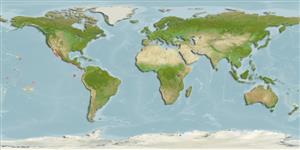Teleostei (teleosts) >
Eupercaria/misc (Various families in series Eupercaria) >
Gerreidae (Mojarras)
Etymology: Eucinostomus: Greek, eu = good + Greek, kyon = dog + Greek, stoma = mouth (Ref. 45335).
Eponymy: Captain John Melmoth Dow (1827–1892) was an American naturalist and explorer, in addition to being a ship’s master and shipping agent. [...] (Ref. 128868), visit book page.
More on author: Gill.
Environment: milieu / climate zone / depth range / distribution range
Ecology
Marine; brackish; demersal. Tropical
Southeast Pacific: Panama to Peru, including the Galapagos Islands.
Size / Weight / Age
Maturity: Lm ? range ? - ? cm
Max length : 20.0 cm TL male/unsexed; (Ref. 55763); common length : 12.0 cm TL male/unsexed; (Ref. 55763); max. published weight: 2.2 kg (Ref. 130775)
Body fusiform, compressed, and not very deep (depth contained 2.5 to 3.3 times in standard length); jaws protrusible; edge of preopercle smooth; second anal spine short and strong; pelvic fins long (1.5 to 1.8 times in head length); body silvery with iridescent green tones; fins transparent except for tips or longest dorsal spines which are black (Ref. 55763).
Body shape (shape guide): fusiform / normal.
Occurs in shallow coastal waters, including estuaries; usually over sand or mud bottoms.
Life cycle and mating behavior
Maturity | Reproduction | Spawning | Eggs | Fecundity | Larvae
Allen, G.R. and D.R. Robertson, 1994. Fishes of the tropical eastern Pacific. University of Hawaii Press, Honolulu. 332 p. (Ref. 11482)
IUCN Red List Status (Ref. 130435: Version 2025-1)
Threat to humans
Harmless
Human uses
Fisheries: bycatch
Tools
Special reports
Download XML
Internet sources
Estimates based on models
Preferred temperature (Ref.
123201): 20.6 - 28.3, mean 24.7 °C (based on 62 cells).
Phylogenetic diversity index (Ref.
82804): PD
50 = 0.5010 [Uniqueness, from 0.5 = low to 2.0 = high].
Bayesian length-weight: a=0.01096 (0.00849 - 0.01416), b=3.10 (3.06 - 3.14), in cm total length, based on LWR estimates for this species (Ref.
93245).
Trophic level (Ref.
69278): 3.2 ±0.3 se; based on size and trophs of closest relatives
Resilience (Ref.
120179): High, minimum population doubling time less than 15 months (Preliminary K or Fecundity.).
Fishing Vulnerability (Ref.
59153): Low vulnerability (10 of 100).
🛈
Nutrients (Ref.
124155): Calcium = 244 [128, 482] mg/100g; Iron = 1.34 [0.70, 2.35] mg/100g; Protein = 18.6 [16.7, 20.3] %; Omega3 = 0.258 [0.141, 0.462] g/100g; Selenium = 43.6 [24.2, 83.9] μg/100g; VitaminA = 19.4 [6.1, 48.9] μg/100g; Zinc = 1.86 [1.28, 2.61] mg/100g (wet weight);
